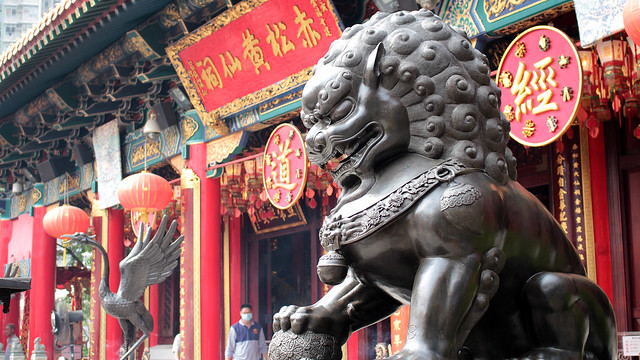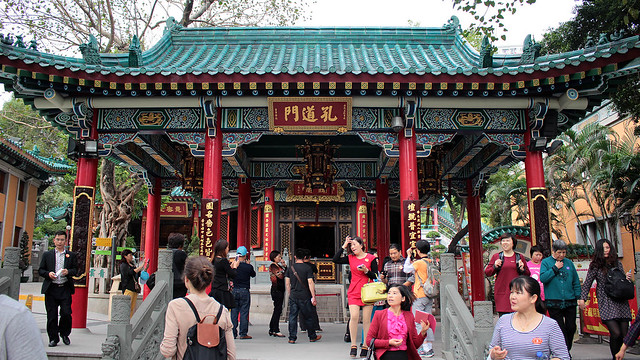The temple of Wong Tai Sin lies a couple of kilometres to the west of the Chi Lin Nunnery and Nan Lian Garden. It is also just one MTR station away from Diamond Hill (“Wong Tai Sin” station, exit B3) for anyone looking for a quick access option, although frankly, it’s easy enough to walk between them. A and I walked it in about 20 minutes.


Home to three different religions: Taoism, Buddhism and Confucianism – there are distinct differences between them even if they’re often lumped together as “Buddhism” – the Wong Tai Sin Temple complex is large and bustling with worshippers and visitors alike. Apparently, there is an one-way system which visitors are encouraged to follow, and during festival periods, this system is compulsory to keep things in order. Well, since we arrived through “Supreme Paradise Gateway” that was definitely not the main entrance, we explored the complex randomly.
Continue reading »
F and I visited quite a number of Hindu temples while in Bali, so it was rather interesting to contrast those with the Hindu temples that we typically see in Malaysia. Not only are they architecturally dissimilar, the customs and practices of the devotees also bear differences. Since we saw the Mother Temple of Besakih in Bali, it was apt that we picked Batu Caves as its counter comparison.
Batu Caves is famed for the annual celebration of Thaipusam, taking place early in the year (January/February) to mark the gifting of a vel (spear) by Parvati, the wife of Shiva, to her son Murugan, created by Shiva from the flame of his eye of wisdom. It was this vel that was ultimately used by Murugan to emerge as victor against Soorapadam, an asura who was terrorising the devas. On Thaipusam, devotees from all over Malaysia, following a strict period of cleansing, fasting and preparation, begin a pilgrimage of kavadi bearing. A kavadi is a burden bore by the devotees to be offered to the deity in exchange for good tiding and/or aversion of serious trial and tribulation. It is an absolutely fascinating festival to observe.


Continue reading »
The Temple of Supreme Bliss, or Kek Lok Si as it is known based on Fujian dialect (the most prominent dialect in Penang) pronounciation, is the most celebrated and largest Buddhist temple in Malaysia. Sitting atop the hill and overlooking Ayer Itam, it is said to be auspiciously located and feng shui-approved to protect the well-being of the temple and its devotees.
Constructed in 1893 under the direction of a well-supported head monk of the Kuan Yin Temple i.e. Temple of the Goddess of Mercy, from local consuls to the Chinese Emperor Guangxu, Kek Lok Si incorporates motifs of Buddhism from Burma, Thailand and China – a nod to both major branches of Buddhism: Mahayana and Theravada. (Note: ask most Chinese Buddhist and they’ll have a hard time telling you which branch of Buddhism they are followers of, in part due to the integration of Taoism to muddle up the mix further.)


Continue reading »
Week two of our holiday came and went. We spent a good few more days snorkelling in the east coast of Peninsular Malaysia (not to be confused with East Malaysia, which is part of Borneo) before we returned to my hometown for yet another family event. The questions that were hovering on everyone’s lips upon seeing me were (1) “Why did you get yourself so tanned?” (Uhmm, there’s no why, just how, and I was enjoying the outdoors for a good bit in the last 2 weeks!”) and (2) “When are you getting married?” (“Honestly, I’m not in any hurry to.”) Nobody seemed to take me seriously on either in any case.
* * *

23 Sep: I have been to Kek Lok Si on multiple occassions and yet somehow, I have never noticed these crystal ceiling lamps before. Not only that, I have also been missing the vibrant colours behind the chandeliers, along with the cobwebs of course. Could it be the (lack of) expectation for decorated ceilings in Asian structures that tend to be unadorned, unlike European palaces and halls that come kitted with extravagant frescoes and decorative elements? If so, I’ve been remissed.
Continue reading »
Our visit to Kandy was far too short to say the least. We arrived in this picturesque city in the early evening – around 4pm – from Dambulla. Our arrival into the city was greeted by some drizzle, but nothing too heavy to hamper our movement. We had booked a room at a budget hotel on Saranankara Road (based on guide books recommendation) but we also ended up checking out a couple of other places just higher up the hill on our driver, Nilan’s advice. We didn’t quite like those so we went back to our first choice, Expeditor Inn.
Reasonably priced, clean and comfortable, we were also pleased to find ourselves with a room with a view – overlooking the Kandy Lake. The receptionist/caretaker was a helpful and friendly lady in her late thirties/early forties (the common room computer was out of order but she let me used her personal laptop – I had to check my emails as I was trying to organise possible meet-up with a friend’s friend but that fell through in the end), and a porter who was thin and lanky was also on hand to assist the move of our luggages from the van to the room. On the fourth floor. By stairs. Ooops… I normally do travel light but this time, with wedding gifts and attires and whats not, the bag was on the heavy side. I felt quite guilty each time someone (well, usually Nilan) had to carry that.

Once everything was settled and we had a little pause, we headed back into town area. More specifically, to try to catch the Kandyan dance performance that was slated for 5.30pm at the Kandyan Arts Association. We got there just in time to purchase our tickets and grabbed a seat pretty much behind most of the other visitors since we were among the last ones in. Nonetheless, this wasn’t one of the busiest nights so the hall remained only half-filled.
The cultural show was very much a tourist-geared event. It was evident when the majority of those seated in the hall were Caucasians, with a handful of South Asian families here and there. However, at 500 LKR per person, the price was a lot more accessible than many many other things that I’ve paid for during the trip. A programme sheet was distributed at the ticketing desk too, so we would have some information on the significance behind each performance. Unfortunately I can’t seem to locate my programme right now (no idea where I’ve stashed them since my recent move) so I can’t exactly match the names of each dance to the photos that I’ve taken… The dancing and drumming performance didn’t just end there – there were also fire-eating and barefeet charcoal-walking to cap the hour of entertainment!
Continue reading »
Buddhism runs deep in Sri Lanka. There are more Buddhist temples on this island than anywhere that I’ve been. Sights of monks in their orange/saffron robes make them stand out from the crowd, even when there’s already a myriad of colours surrounding them. Besides the temples, on street corners and main junctions everywhere, it is not unusual either to see a shrine, sometimes almost unnoticeably small, sometimes magnificent and breathtaking, paying homage to the Buddhas sheltered by a sacred Bo tree nearby.
Day 2 of our trip continued from Sigiriya, which at one point of time in history was also a monastery site, heading towards Dambulla for the famous cave temples before travelling further south to Kandy, home to the country’s most important shrine, the Temple of the Tooth. But let’s not get too far ahead. First, we’ll take a peek at the cave temples.

Dambulla on its own, is a small dusty town. A main street lined with shops, some in relatively modern multi-storey premises, others low wooden huts, and one should not be surprised either to see incompletely constructed buildings already in use – something we noticed no matter where we went.
The cave temples are located a couple of kilometres south of centre Dambulla. It would be hard to miss, given that the Golden Temple lies at the bottom of the steps leading to the temples. The Golden Temple boasted a gigantic golden (of course) Buddha, seated cross-legged over a lion’s head (its mouth the entrance to the temple – reminiscent of the idea from Sigiriya?). We did not enter the temple itself but walked around for a quick peek while waiting for the ticket counter to the cave temples to open after the lunch hour.
Continue reading »

Ok, I’ve been on temple overload this month and it seems you’re on the receiving end too. Between Sri Lanka and Malaysia, I have seen enough statues of Buddha to last me for a while, and taken enough photos too that while sorting through them, I’m getting confused of which is which! Additionally, in Sri Lanka, a shrine can be found easily even along any main road that one takes, so I couldn’t even tell you where I have seen which. Ooops.
This will be the last among the temple-related photos for now though. I’m heading back to Paris tomorrow, but before that, a visit to our local temple is a must, for a prayer of safe journey for myself and good health for my family. The tiger god is a guardian spirit of the temple and from where I stand, it looks calm yet alert and stern, ready to confer its protection. I feel strangely serene here.

Ipoh is a former tin mining town, surrounded by caves within limestone hills, a number of which are pilgrimage sites for Buddhist devotees and for visiting tourists to the area. Among the most famous are Perak Cave, Sam Po Tong and Kek Lok Tong, each with impressive temple settings as well as scenic views atop the hills.
In the distant, from Kinta City, one of them can clearly be seen, except with my poor orientation and carelessness in not noting exactly where I was looking, I can’t tell you which it is. I can only deduce that since we were in the south of Ipoh, it would be either Sam Po Tong or Kek Lok Tong? Who wants to play guess the cave temple? ;)

A temple near home recently underwent some serious renovation and they certainly up the ante at the scale level, particularly with the erection of various statues of a pantheon of deities normally worshipped by those practicing Taoism/Confucianism. Some of them are about the height of 2-3 storeys building!
They also added some traditional decorative elements, such as this guardian temple lion, at the gate to the square of deities. The lions always come in pair, usually one with mouth open and one with mouth shut. They are signs of courage and strength, and protection against bad luck and evil. I am simply drawn to the playful nature depicted by this lion, that life is free of worry and there are bundles of good in the world.
























